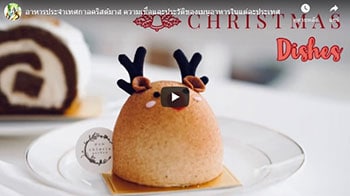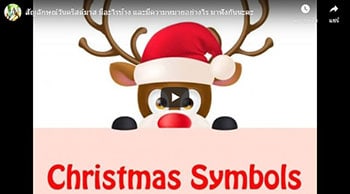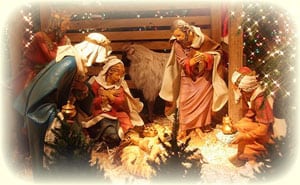ประวัติวันคริสต์มาส ประวัติคริสต์มาส ความเป็นมา Christmas History

ทางลัดไปยังข้อมูลที่สำคัญ
- หน้าหลัก วันคริสต์มาส
- ประวัติพระเยซู
- ประวัติซานตาคลอส
- คำอวยพรวันคริสต์มาส
- กิจกรรมในวันคริสต์มาส
- สัญลักษณ์วันคริสต์มาส
- Boxing Day คืออะไร
- Christmas Eve คืออะไร
- Thanksgiving คืออะไร
- Black Friday คืออะไร
- แนะนำภาพยนต์คริสต์มาส
วิดิโอแนะนำเกี่ยวกับวันคริสต์มาส
ประวัติวันคริสต์มาส
Christmas or Christmas Day is an annual holiday celebrated on December 25 that commemorates the birth of Jesus of Nazareth. The date of commemoration is not known to be Jesus’ actual birthday, and may have initially been chosen to correspond with either a historical Roman festival or the winter solstice. Christmas is central to the Christmas and holiday season, and in Christianity marks the beginning of the larger season of Christmastide, which lasts twelve days.
วันคริสต์มาสเป็นวันหยุดประจำปี ที่จัดขึ้นเพื่อเฉลิมฉลองการประสูติของพระเยซูซึ่งตรงกับวันที่ 25 ธันวาคม โดยวันดังกล่าวอาจจะไม่ตรงกับวันเกิดจริงๆของพระเยซู แต่อาจจะเป็นวันที่ถูกเลือกเอาไว้เพื่อให้สอดคล้องกับเทศกาลโรมัน หรือสอดคล้องกับวันที่มีช่วงเวลากลางวันสั้นที่สุด (winter solstice)คริสต์มาสเป็นเทศกาลที่สำคัญ และมีการฉลองอย่างยิ่งใหญ่ ในย่านของชาวคริสเตียนนั้นจะมีการจัดเทศกาลนี้ยาวนานถึง 12 วัน
Although traditionally a Christian holiday, Christmas is widely celebrated by many non-Christians, andsome of its popular celebratory customs have pre-Christian or secular themes and origins. Popular modern customsof the holiday include gift-giving, Christmas carols, an exchange of greeting cards, church celebrations, a special meal,and the display of various decorations; including Christmas trees, lights, and garlands, mistletoe, nativity scenes, and holly. In addition, Father Christmas (known as Santa Claus in North America and Ireland) is a popular mythological figure in many countries, associated with the bringing of gifts for children.
แม้ว่าวันคริสต์มาสจะเป็นเทศกาลของชาวคริสต์ แต่ในหมู่คนที่ไม่ใช่ชาวคริสต์ก็มีการเฉลิมฉลองกันอย่างแพร่หลายเช่นกัน ซึ่งการเฉลิมฉลองนั้นมีทั้งแบบสมัยใหม่ที่ไม่เกี่ยวข้องกับศาสนาเลยกับอีกแบบหนึ่งคือแบบดั้งเดิม โดยประเพณีที่เป็นนิยมในสมัยใหม่นั้น ได้แก่ การมอบของขวัญ การแลกเปลี่ยนการ์ดอวยพร
การจัดงานเลี้ยงฉลองในโบสถ์ การรับประทานอาหารมื้อพิเศษ และการโชว์งานตกแต่งประดับประดาตามสถานที่ต่าง ๆด้วย ต้นคริสต์มาส ดวงไฟประดับ พวงดอกไม้ ต้นมิสเซิลโท การแสดงเกี่ยวกับวันประสูติของพระเยซู และต้นฮอลลี่ นอกจากนี้บิดาแห่งคริสต์มาส (หรือที่ชาวอเมริกาเหนือและไอร์แลนด์เรียกว่า ซานตาคลอส) ยังเป็นหนึ่งตำนานที่เป็นที่รู้จักกันว่าเป็นผู้นำของขวัญมามอบให้กับเด็ก ๆ
Because gift-giving and many other aspects of the Christmas festival involve heightened economicactivity among both Christians and non-Christians, the holiday has become a significant event and a key sales period for retailers and businesses. The economic impact of Christmas is a factor that has grown steadily over the past few centuries in many regions of the world.
เนื่องจากการมอบของขวัญและการฉลองทั้งหลายนี้ ส่งผลต่อระบบเศรษฐกิจสูงมาก ทั้งในเมืองของชาวคริสเตียน และที่ไม่ใช่ชาวคริสเตียนเทศกาลคริสต์มาสจึงกลายเป็นช่วงเวลาที่สำคัญในการขายของสำหรับเหล่าพ่อค้าและนักธุรกิจการที่ระบบเศรษฐกิจได้รับการกระตุ้นจากเทศกาลนี้คือปัจจัยสำคัญที่ทำให้เกิดการเติบโตอย่างต่อเนื่องในทั่วทุกพื้นที่ในช่วง 2-3 ศตวรรษที่ผ่านมานี้
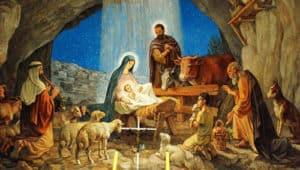
คำค้น ประวัติวันคริสต์มาส ประวัติคริสต์มาส ความเป็นมา เทศกาลคริสต์มาส Christmas History แปล
ที่มาของคำว่า คริสต์มาส
The word Christmas originated as a compound meaning “Christ’s Mass”. It is derived from the Middle English Christemasse and Old English Cristes mæsse, a phrase first recorded in 1038. “Cristes” is from Greek Christos and “mæsse” is from Latin missa. In Greek, the letter (chi), is the first letter of Christ, and it, or the similar Roman letter X, has been used as an abbreviation for Christ since the mid-16th century. Hence, Xmas is often used as an abbreviation for Christmas.
คำว่า คริสต์มาส มีที่มาจากคำประสม คำว่า “Christ’s Mass” ซึ่งมีรากคำมาจากคำว่า Christemasse ของภาษาอังกฤษยุคกลาง และ คำว่า Cristes mæsse จากภาษาอังกฤษโบราณซึ่งมีการบันทึกคำดังกล่าวครั้งแรกไว้ในปี 1038
คำว่า Cristes มาจากพระเยซูคริสต์ของกรีก และคำว่า mæsse มาจากหนังสือสวดมนตร์ของชาวละติน ในภาษากรีกตัวอักษร X เป็นตัวอักษรแรกของคำว่า “Christ” ซึ่งคล้ายกับตัว X ในภาษาโรมัน จึงมีการใช้ X แทน Christ ตั้งแต่กลางศตวรรษที่ 16 ดังนั้นจึงนิยมใช้คำว่า Xmas แทน Christmas


ประวัติคริสต์มาส
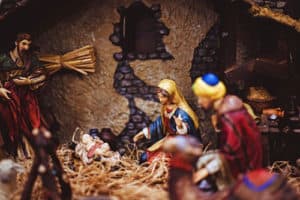
For many centuries, Christian writers accepted that Christmas was the actual date on which Jesus was born. However, in the early eighteenth century, scholars began proposing alternative explanations. Isaac Newton argued that the date of Christmas was selected to correspond with the winter solstice, which in ancient times was marked on December 25. In 1743, German Protestant Paul Ernst Jablonski argued Christmas was placed on December 25 to correspond with the Roman solar holiday Dies Natalis Solis Invicti and was therefore a “paganization” that debased the true church. In 1889, Louis Duchesne suggested that the date of Christmas was calculated as nine months after the Annunciation (March 25), the traditional date of the Incarnation.
เป็นเวลาหลายศตวรรษที่นักเขียนชาวคริสเตียนยอมรับว่าวันคริสต์มาสนั้นตรงกับวันประสูติของพระเยซู อย่างไรก็ตาม ในช่วงต้นศตวรรษที่ 18 ก็เริ่มมีนักวิชาการนำเสนอคำอธิบายเพิ่มเติม ไอแซค นิวตัน ให้ความเห็นว่าวันคริสต์มาสนั้นถูกเลือกขึ้นมาเพื่อให้สอดคล้องกับช่วง วันที่มีกลางวันสั้นที่สุด (winter solstice) ซึ่งในอดีตได้กำหนดไว้ให้ตรงกับวันที่ 25 ธันวาคม
ปี 1743 Paul Ernst Jablonski ชาวเยอรมันที่นับถือคริสต์นิกายโปแตสแตนซ์ ให้ความเห็นว่าวันคริสต์มาสนั้นระบุให้ตรงกับวันที่ 25 ธันวาคม เพื่อให้สอดคล้องกับวันหยุด Roman Solar Holiday Dies Natalis Solis Invicti และโดยเหตุการณ์นั้น พวกนอกรีตได้ทำให้โบสถ์ดูไม่น่าเลื่อมใส และหมดความศรัทธา
ปี 1889 Louis Duchesne กล่าวว่าวันคริสต์มาสถูกคำนวณจากวัน Annunciation ไปอีก 9 เดือน วัน Annunciation ตรงกับวันที่ 25 มีนาคม ซึ่งเป็นวันที่ระลึกถึงการกลับชาติมาเกิดของนางฟ้ากาเบรียล ซึ่งจุติเป็นพระแม่มารี ซึ่งตามประเพณีแล้วถือว่าเป็นวันแห่งการลงมาจุติยังโลกมนุษย์

Pre-Christian background
Dies Natalis Solis Invicti means “the birthday of the unconquered Sun.” The use of the title Sol Invictus allowed several solar deities to be worshipped collectively, including Elah-Gabal, a Syrian sun god; Sol, the god of Emperor Aurelian; and Mithras, a soldiers’ god of Persian origin. Emperor Elagabalus (218–222) introduced the festival, and it reached the height of its popularity under Aurelian, who promoted it as an empire-wide holiday. This day had held no significance in the Roman festive calendar until it was introduced in the third century.
Dies Natalis Solis Invicti หมายความว่า “วันเกิดของเทพเจ้าแห่งพระอาทิตย์ ผู้ที่ไม่มีใครเอาชนะได้” การใช้คำนำหน้า Sol Invictus จะอนุญาตให้ใช้กับเทพแห่งดวงอาทิตย์ที่ได้รับการให้ความเคารพในชนหมู่มาก ได้แก่ Elah-Gabal, เทพแห่งดวงอาทิตย์ของชาวซีเรีย Sol เทพซึ่งเป็นจักรพรรดิของชาว Aurelian และ Mithras องครักษ์เทพของชาวเปอร์เซียพื้นเมือง จักรพรรดิ Elagabalus (ปี 218-222) เป็นผู้นำเอาประเพณีนี้เข้ามา ซึ่งได้รับความนิยมมากในหมู่ชาว Aurelian ซึ่งต่อมาได้กลายมาเป็นวันหยุดประจำราชอาณาจักร แต่เทศกาลนี้ก็ไม่ได้รับการระบุลงในปฏิทินเทศกาลของโรมัน จนกระทั่งศตวรรษที่ 3 Dies Natalis Solis Invicti

The festival was placed on the date of the solstice because this was on this day that the Sun reversed its southward retreat and proved itself to be “unconquered.”Several early Christian writers connected the rebirth of the sun to the birth of Jesus. “O, how wonderfully acted Providence that on that day on which that Sun was born…Christ should be born”, Cyprian wrote. John Chrysostom also commented on the connection: “They call it the ‘Birthday of the Unconquered’. Who indeed is so unconquered as Our Lord . . .?”
เทศกาลนี้ถูกระบุลงในวันที่กลางวันสั้นที่สุด เพราะเป็นวันที่ดวงอาทิตย์หมุนกลับไปทางใต้เพื่อจะพิสูจน์ถึงการ “ไม่อาจเอาชนะได้” ซึ่งนักเขียนชาวคริสเตียนหลายคนได้เชื่อมเอาการกลับมาของดวงอาทิตย์ไปโยงกับการประสูติขององค์พระเยซู Cyprian ได้เขียนเอาไว้ว่า “การกำเนิดของดวงอาทิตย์ช่างงดงาม….พระเยซูคริสต์เองก็ควรประสูติในวันเช่นนี้” John Chrysostom เองก็ได้เขียนเอาไว้เช่นกันว่า “พวกเขาเรียกวันนั้นว่า วันเกิดของผู้ที่ไม่มีใครเอาชนะได้ แล้วใครกันที่จะไม่มีวันพ่าย หากไม่ใช่พระผู้เป็นเจ้า”

เทศกาลฤดูหนาว
A winter festival was the most popular festival of the year inmany cultures. Reasons included the fact that less agricultural workneeds to be done during the winter, as well as an expectation of better weather as spring approached. Modern Christmas customs include: gift-giving and merrymaking from Roman Saturnalia; greenery, lights, and charity from the Roman New Year; and Yule logs and various foods from Germanic feasts. Pagan Scandinavia celebrated a winter festival called Yule, held in the late December to early January period. As Northern Europe was the last part to Christianize, its pagan traditions had a major influence on Christmas. Scandinavians still call Christmas Jul. In English, the word Yule is synonymous with Christmas, a usage first recorded in 900.
เทศกาลฤดูหนาวคือเทศกาลที่ประชาชนให้ความนิยมสูงสุดกันมาช้านานในหลายประเทศด้วยเหตุผลหลายประการ รวมถึงงานด้านเกษตรกรรมมีไม่มากนักในช่วงฤดูหนาวและเพราะการตั้งความหวังว่าสภาพอากาศจะดีขึ้นเมื่อฤดูใบไม้ผลิแวะเวียนมาถึงกิจกรรมของคริสต์มาสสมัยใหม่นั้น ประกอบด้วย การมอบของขวัญ การเฉลิมฉลองเพื่อบูชาเทพเจ้าของชาวโรมันการประดับสถานที่ด้วยพืชพันธุ์สีเขียวและแสงไฟ รวมถึงงานการกุศลในวันปีใหม่ของชาวโรมันการก่อกองไฟจากท่อนไม้ขนาดใหญ่ และสำหรับชาวเยอรมันจะมีการเลี้ยงฉลองด้วยอากหารหลากชนิดปฏิทินของชาวเพเกน สแกนดิเนียเวีย ฉลองเทศกาลฤดูหนาวโดยใช้ชื่อว่า ยูล ซึ่งจะจัดขึ้นในปลายเดือนธันวาคมถึงต้นเดือนมกราคม เนื่องจากทางตอนเหนือของยุโรปเป็นพื้นที่ท้ายๆที่นับถือศาสนาคริสต์ ซึ่งวัฒนธรรมเพเกนเองก็ได้รับอิทธิพลมาจากวันคริสต์มาสชาวสแกนดิเนเวียนยังคงเรียกวันคริสต์มาสว่า คริสต์มาส จูล ในภาษาอังกฤษคำว่ายูลนั้นมีความหมายเหมือนกับคำว่าคริสต์มาส ซึ่งมีการบันทึกการใช้ครั้งแรกในปี 900

ความเป็นมาของผู้ที่นับถือศาสนาคริสต์
The New Testament does not give a date for the birth of Jesus. Around AD 200, Clement of Alexandria wrote that a group in Egypt celebrated the nativity on Pachon 25. This corresponds to May 20. Tertullian (d. 220) does not mention Christmas as a major feast day in the Church of Roman Africa.
However, in Chronographai, a reference work published in 221, Sextus Julius Africanus suggested that Jesus was conceived on the spring equinox, popularizing the idea that Christ was born on December 25. The equinox was March 25 on the Roman calendar, so this implied a birth in December. De Pascha Computus, a calendar of feasts produced in 243, gives March 28 as the date of the nativity. In 245, the theologian Origen of Alexandria stated that, “only sinners (like Pharaoh and Herod)” celebrated their birthdays. In 303, Christian writer Arnobius ridiculed the idea of celebrating the birthdays of gods, which suggests that Christmas was not yet a feast at this time.
พระคัมภีร์ไบเบิลเล่มใหม่ไม่ได้ระบุถึงวันประสูติของพระเยซู ซึ่งประมาณปีคริสต์ศักราชที่ 200จากความเมตตาของพระเจ้าอเล็กซานเดอร์ ทำให้ชนชาวอิยิปเฉลิมฉลองเทศกาลงานคล้ายวันประสูติที่ Pachon 25 ได้ ซึ่งตรงกับวันที่ 20 พฤษภาคม
ชนชาว Tertullian เมื่อคริสต์ศักราชที่ 220 ไม่ได้เอ่ยถึงความสำคัญของเทศกาลคริสต์มาสที่มีผลกระทบอย่างมากต่องานวันเฉลิมฉลองที่จัดขึ้นในโบสถ์ของชาวโรมัน – แอฟริกา
อย่างไรก็ตาม ใน Chronographai หนังสืออ้างอิงซึ่งได้เผยแพร่ในปี 221, Sextus Julius Africanusได้บรรยายไว้ว่า การตั้งครรภ์พระเยซู เกิดขึ้นในฤดูใบไม้ผลิ ของวันที่กลางวันและกลางคืนยาวเท่ากัน ดังนั้น จึงเกิดความคิดที่แพร่หลายกันว่าพระเยซูประสูติในวันที่ 25 ธันวาคม ซึ่งวันที่กลางวันและกลางคืนยาวเท่ากันตามปฏิทินของชาวโรมันนั้น คือวันที่ 25 มีนาคมทำให้เกิดความเข้าใจกันว่าการประสูติจะอยู่ในเดือนธันวาคม
De Pascha Computus คือปฏิทินของวันเฉลิมฉลอง จัดทำขึ้นในปี 243 ได้ระบุให้วันที่ 28 มีนาคม เป็นวันแห่งการกำเนิดของพระเยซู ในปี 245 นักเทววิทยา Origen of Alexandria ได้เปิดประเด็นว่ามีแต่คนบาปเท่านั้น (เช่น ฟาร์โร และเฮร็อด) ที่เฉลิมฉลองวันเกิดของตนเอง ในปี 303 นักเขียนคริสเตียนที่ชื่อ Arnobius เยาะเย้ยความคิดในเรื่องการเฉลิมฉลองวันประสูติของพระผู้เป็นเจ้า ซึ่งเขาได้แนะนำว่าวันคริสต์มาสไม่ใช่ช่วงเวลาที่เหมาะสมในการจัดงานเฉลิมฉลอง
จุดเริ่มต้นของเทศกาล
An early reference to the date of the nativity as December 25 is found in the Chronography of 354, an illuminated manuscript compiled in Rome in 354. In the East, early Christians celebrated the birth of Christ as part of Epiphany (January 6), although this festival emphasized celebration of the baptism of Jesus.
Christmas was promoted in the Christian East as part of the revival of Catholicism following the death of the pro-Arian Emperor Valens at the Battle of Adrianople in 378. The feast was introduced to Constantinople in 379, and to Antioch in about 380. The feast disappeared after Gregory of Nazianzus resigned as bishop in 381, although it was reintroduced by John Chrysostom in about 400.
มีการค้นพบเอกสารที่อ้างอิงว่าพระเยซูประสูติในวันที่ 25 ธันวาคม ใน the Chronography of 354 ซึ่งเป็นต้นฉบับที่รวบรวมไว้ในกรุงโรมเมื่อปี 354 ชาวคริสต์ทางตะวันออกจะถือเอาการเฉลิมฉลองวันประสูติของพระเยซูเป็น ส่วนหนึ่งของวัน Epiphany (6 มกราคม) แม้ว่าวัน Epiphany นี้ จะเน้นที่พิธีกรรมการล้างบาปก็ตาม
เทศกาลคริสต์มาสเป็นที่รู้จักของชาวคริสเตียนตะวันออกในส่วนของการฟื้นฟู ศาสนาคริสต์นิกายโรมันคาทอลิกขึ้นมาใหม่ หลังจากการสิ้นพระชนม์ของจักรพรรดิ Arian Emperor Valens ที่สมรภูมิ Adrianople ในปี 378 การฉลองเริ่มเป็นที่รู้จักในเมือง Constantinople เมื่อปี 379 และเมือง Antioch ในปี 380 แล้วประเพณีการเฉลิมฉลองก็เลือนหายไปหลังจากที่ Gregory แห่ง Nazianzus ลาออกจากตำแหน่งบิช็อปในปี 381 และก็ถูก John Chrysostom นำกลับมาเผยแพร่อีกครั้งในช่วงปี 400

 ในช่วงยุคกลาง
ในช่วงยุคกลาง
In the Early Middle Ages, Christmas Day was overshadowed by Epiphany, which in the west focused on the visit of the magi. But the Medieval calendar was dominated by Christmas-related holidays. The forty days before Christmas became the “forty days of St. Martin” (which began on November 11, the Afeast of St. Martin of Tours), now known as Advent. In Italy, former Saturnalian traditions were attached to Advent. Around the 12th century, these traditions transferred again to the Twelve Days of Christmas (December 25 – January 5); a time that appears in the liturgical calendars as Christmastide or Twelve Holy Days.
ยุคกลาง
ในช่วงแรกของยุคกลางนั้นเทศกาลคริสต์มาสถูกลดความสำคัญลงเนื่องจากวัน Epiphany เพราะชาวตะวันตกมุ่งความสนใจให้กับการเข้ามาของพวกมากิ (นักแสวงบุญ) แต่ในปฏิทินของยุคกลางกลับระบุถึงเทศกาลที่เกี่ยวกับวันคริสต์มาส สี่สิบวันก่อนถึงวันคริสต์มาสกลับกลายมาเป็น“สี่สิบวันของเซ็นต์มาร์ติน” (งานฉลองเซ็นต์มาร์ตินจะเริ่มจากวันที่ 11 พฤศจิกายน) ซึ่งปัจจุบันรู้จักกันในชื่อ “Advent”
ในประเทศอิตาลี ประเพณีบูชาพระเจ้าในอดีตถูกรวมให้ปฏิบัติกิจกรรมในวัน “Advent” ด้วยเช่นกัน ราวศตวรรษที่ 12 ประเพณีนี้ถูกย้ายไปอยู่ใน “12 วันแห่งคริสต์มาส” (25 ธันวาคม – 5 มกราคม) ช่วงเวลาดังกล่าว ถูกระบุเอาไว้ในปฏิทินว่าเป็นช่วง “Christmastide” หรือสิบสองวันศักดิ์สิทธิ์
The prominence of Christmas Day increased gradually after Charlemagne was crowned Emperor on Christmas Day in 800. King Edmund the Martyr was anointed on Christmas in 855 and King William I of England was crowned on Christmas Day 1066.
ความสำคัญของวันคริสต์มาสเพิ่มมากขึ้นเมื่อ Charlemagne ได้ครองตำแหน่งจักรพรรดิในวันคริสต์มาสในปี 800 ส่วนกษัตริย์ Edmund the Martyr ได้รับการแต่งตั้งเมื่อวันคริสต์มาสปี 855 และกษัตริย์วิลเลี่ยมที่ 1 แห่งอังกฤษได้รับตำแหน่งจักรพรรดิในวันคริสต์มาสปี 1066
By the High Middle Ages, the holiday had become so prominent that chroniclers routinely noted where various magnates celebrated Christmas. King Richard II of England hosted a Christmas feast in 1377 at which twenty-eight oxen and three hundred sheep were eaten. The Yule boar was a common feature of medieval Christmas feasts. Caroling also became popular, and was originally a group of dancers who sang. The group was composed of a lead singer and a ring of dancers that provided the chorus. Various writers of the time condemned caroling as lewd, indicating that the unruly traditions of Saturnalia and Yule may have continued in this form. “Misrule”—drunkenness, promiscuity, gambling—was also an important aspect of the festival. In England, gifts were exchanged on New Year’s Day, and there was special Christmas ale.
คริสต์มาสกลายมาเป็นเทศกาลที่มีการเฉลิมฉลองเป็นประจำในยุครุ่งเรืองของสมัยกลางซึ่งมักมีบุคคลสำคัญฉลองเทศกาลนี้ โดยกษัตริย์ริชาร์ตที่ 2 แห่งอังกฤษได้จัดงานเลี้ยงคริสต์มาสในปี 1377ซึ่งในงานมีการกินเลี้ยงวัวยี่สิบแปดตัว และแกะอีกสามร้อยตัว
หมูป่าประจำวันคริสต์มาสถือเป็นสัญลักษณ์ของงานฉลองคริสต์มาสในยุคกลางการร้องประสานเสียงเริ่มได้ความนิยมมากขึ้น แล้วก็เป็นจุดเริ่มต้นของนักเต้นซึ่งสมาชิกก็มาจากกลุ่มนักร้องประสานเสียงนั่นเอง โดยวงจะประกอบไปด้วยนักร้องนำและมีนักเต้นซึ่งจะล้อมรอบนักร้องนำเป็นผู้ร้องประสานเสียงด้วย นักเขียนหลายคนในยุคนั้นวิจารณ์นักร้องประสานเสียงนั้นว่าเต็มไปด้วยตัณหา และชี้ให้เห็นว่า ประเพณีการบูชาเทพเจ้าที่ไร้วินัยแบบนี้จะยังคงเป็นอยู่แบบนี้ไปเรื่อย ๆการทำผิดกฎ ขี้เหล้าเมายา การผิดประเวณี และเล่นการพนัน กลายเป็นส่วนสำคัญของกิจกรรมงานฉลองในอังกฤษมีการแลกเปลี่ยนของขวัญในวันปีใหม่ ซึ่งก็มีการแลกเปลี่ยนเครื่องดื่มที่มีแอลกอฮอล์สำหรับวันคริสต์มาสในวันนั้นด้วย
Christmas during the Middle Ages was a public festival that incorporating ivy, holly, and other evergreens. Christmas gift-giving during the Middle Ages was usually between people with legal relationships, such as tenant and landlord. The annual indulgence in eating, dancing, singing, sporting, card playing escalated in England, and by the 17th century the Christmas season featured lavish dinners, elaborate masques and pageants. In 1607, King James I insisted that a play be acted on Christmas night and that the court indulge in games.
เทศกาลคริสต์มาสในช่วงยุคกลางเป็นเทศกาลระดับชาติที่รวมเอาไม้เลื้อย ต้นฮอลลีและพืชใบเขียวอื่นๆมาประดับตกแต่งตามสถานที่ต่างๆ แต่ว่าการแลกของขวัญคริสต์มาสในยุคกลางนั้นจะมีก็แต่เฉพาะกลุ่มคนที่มีความสัมพันธ์กันทางกฎหมายเท่านั้น เช่น ผู้เช่ากับผู้ให้เช่า ในอังกฤษเริ่มมีการจัดงานเลี้ยง งานร้องรำทำเพลง เล่นกีฬา หรือเกมส์ไพ่มากขึ้นเรื่อยๆ จนกระทั่งศตวรรษที่ 17 เทศกาลคริสต์มาสก็เริ่มมีงานเลี้ยงที่หรูหรา ฟุ่มเฟือยและการประกวดหน้ากาก, ในปี 1607 กษัตริย์เจมส์ที่ 1 ก็ยืนกรานให้มีการเล่นละครในคืนวันคริสต์มาส ซึ่งกระบวนการทางศาลก็ยอมผ่อนผันให้สามารถเล่นได้

การปฏิรูปสู่ศตวรรษที่ 19
Following the Protestant Reformation, groups such as the Puritans strongly condemned the celebration of Christmas, considering it a Catholic invention and the “trappings of popery” or the “rags of the Beast.” The Catholic Church responded by promoting the festival in a more religiously oriented form. King Charles I of England directed his noblemen and gentry to return to their landed estates in midwinter to keep up their old style Christmas generosity. Following the Parliamentarian victory over Charles I during the English Civil War,England’s Puritan rulers banned Christmas in 1647. Protests followed as pro-Christmas rioting broke out in several cities and for weeks Canterbury was controlled by the rioters, who decorated doorways with holly and shouted royalist slogans. The book, The Vindication of Christmas (London, 1652), argued against the Puritans, and makes note of Old English Christmas traditions, dinner, roast apples on the fire, card playing, dances with “plow-boys” and “maidservants”, and carol singing. The Restoration of King Charles II in 1660 ended the ban, but many clergymen still disapproved of Christmas celebration. In Scotland, the Presbyterian Church of Scotland also discouraged observance of Christmas. James VI commanded its celebration in 1618, however attendance at church was scant.
ในระหว่างการปฏิรูปของนิกายโปรแตสแต้นท์ กลุ่มคนที่เคร่งครัดในศีลธรรมได้วิจารณ์ว่าการฉลองเทศกาลคริสต์มาสของชาวคาทอลิกว่า เป็นเหมือน “คำสอนที่เป็นได้แค่เครื่องประกอบ” และ “ความเดือดดาลของสัตว์ร้าย” ดังนั้นโบสถ์นิกายโรมันคาทอลิกได้ส่งเสริมให้เทศกาลนี้น่าเลื่อมใสมากขึ้นโดยเน้นพิธีกรรมทางศาสนามากขึ้น จากนั้น กษัตริย์ชาลส์ที่ 1 ได้สั่งการให้เหล่าขุนนางและชนชั้นสูงกลับบ้านเกิดในช่วงกลางฤดูหนาวเพื่อคงไว้ซึ่งประเพณีดั้งเดิมของวันคริสต์มาส
จากชัยชนะของฝ่ายรัฐสภาเหนือฝ่ายกษัตริย์ชาลส์ที่ 1 ในสงครามกลางเมืองในปี 1647ประมุขของกลุ่มผู้เคร่งครัดในศาสนาก็ได้ยกเลิกเทศกาลนี้ และสิ่งที่ตามมาก็คือเกิดก่อจลาจลจากผู้ต่อต้านในหลายเมือง และประมาณหนึ่งสัปดาห์ต่อมาเมืองแคนเทอบิวรี่ก็ตกอยู่ในความควบคุมของกลุ่มผู้ก่อการจลาจล ซึ่งพวกเขาได้ตกแต่งทางเข้าออกด้วยดอกฮอลลิ และคอยตะโกนกล่าวคำสรรเสริญกษัตริย์ของพวกเขายังมีข้อความในหนังสือ The Vindication of Christmas (London, 1652) ที่โต้แย้งกลุ่มผู้เคร่งครัดทางศาสนา และบันทึกประเพณีการฉลองคริสต์มาสแบบเก่าของอังกฤษซึ่งประกอบด้วย การทานอาหารค่ำ การปิ้งแอปเปิ้ล เล่นไพ่ การเต้นรำกับเด็กชายท้องนาและสาวรับใช้ และร่วมร้องเพลงประสานเสียง จนมาถึงปี 1660 ในยุคฟื้นฟูสมัยของกษัตริย์ชาลส์ที่ 2 การยกเลิกงานเทศกาลก็สิ้นสุดลง แต่พวกนักบวชก็ยังคงไม่ยอมรับการเฉลิมฉลอง ในประเทศสก็อตแลนด์ โบสถ์ของชาวโปรแตสแตนท์นั้นไม่เห็นด้วยการการเฉลิมฉลองนี้เหมือนกัน กษัตริย์เจมส์ที่หกได้สั่งให้มีการจัดงานฉลองคริสต์มาสต์แต่กลับมีผู้มาร่วมงานน้อย
In Colonial America, the Puritans of New England shared radical protestant disapproval of Christmas. Celebration was outlawed in Boston from 1659 to 1681. The ban by the Pilgrims was revoked in 1681 by English governor Sir Edmund Andros, however it wasn’t until the mid 1800’s that celebrating Christmas became fashionable in the Boston region. At the same time, Christian residents of Virginia and New Yorkobserved the holiday freely. Pennsylvania German Settlers, pre-eminently the Moravian settlers of Bethlehem, Nazareth and Lititz in Pennsylvania and the Wachovia Settlements in North Carolina, were enthusiastic celebrators of Christmas. The Moravians in Bethlehem had the first Christmas trees in America as well as the first Nativity Scenes. Christmas fell out of favor in the United States after the American Revolution, when it was considered an English custom. George Washington attacked Hessian mercenaries on Christmas during the Battle of Trenton in 1777. (Christmas being much more popular in Germany than in America at this time.)
รัฐปูริตานส์แห่งนิว อิงแลนด์ อาณานิคมของอเมริกา ได้ถูกพวกเคร่งศาสนานิกายโปรแตสแต้นท์ขัดขวางและต่อต้านงานเทศกาล แต่ในปี 1659 ถึง 1681 มีการฉลองอย่างผิดกฎหมายในเมืองบอสตันซึ่งต่อมาการขัดขางและต่อต้านนี้ ได้ถูกยกเลิกโดยผู้ว่าการชาวอังกฤษชื่อ Sir Edmund Andros ในปี 1681 อย่างไรก็ตามงานฉลองประเพณีคริสต์มาสก็ยังไม่ได้รับการตอบรับเท่าที่ควรจนกระทั่งกลางปีที่ 1800 ความนิยมในเทศกาลนี้ถึงกระจายไปทั่วพื้นที่ของเมืองบอสตัน ในเวลาเดียวกัน ชาวคริสเตียนในเวอร์จีเนียและนิวยอร์กต่างได้รับอิสระในการฉลองประเพณีนี้ผู้ตั้งถิ่นฐานชาวเยอรมันในเมืองเพนซิวาเนีย, ชาวโมราเวียนซึ่งมีอยู่น้อยมากในเมืองเบธเลเฮม, ชาวนาซาเรซ และลิทิซ ในเมืองเพนซิวาเนีย และ ชาววาโชเวียในนอร์ท คาโรไรน่าตื่นตัวมากที่จะได้ฉลองกับเทศกาลคริสต์มาส, ชาวโมราเวียนในเมืองเบธเลเฮมมีต้นคริสต์มาสต้นแรกของอเมริกาเช่นเดียวกับฉากการประสูติของพระเยซูก็เกิดขึ้นครั้งแรกที่นี่แต่หลังจากการปฏิวัติอเมริกา เทศกาลคริสต์มาสก็เริ่มเสื่อมความนิยมลงเมื่อทุกคนต่างลงความเห็นว่าคริสต์มาสเป็นเทศกาลของชาวอังกฤษ ปี 1777 จอร์จ วอชิงตันได้โจมตีกลุ่มพ่อค้าชาวเฮซเซียนในวันคริสต์มาสในสมรภูมิ the Battle of Trenton (ในช่วงเวลานี้เทศกาลคริสต์มาสเป็นที่นิยมในเยอรมันมากกว่าอเมริกา)
By the 1820s, sectarian tension had eased in Britain and writers, including William Winstanly, began to worry that Christmas was dying out. These writers imagined Tudor Christmas as a time of heartfelt celebration, and efforts were made to revive the holiday. Charles Dickens’ novel A Christmas Carol, published in 1843, helped revive the ‘spirit’ of Christmas and seasonal merriment. Its instant popularity played a major role in portraying Christmas as a holiday emphasizing family, goodwill, and compassion. Prominent phrases in Dickens’ Yultide tale, ‘Bah! Humbug!’, and ‘Merry Christmas’, grew in usage in the English language. Also in 1843, the first Christmas card was produced by Sir Henry Cole. The revival of the Christmas Carol began with William B. Sandys Christmas Carols Ancient and Modern (1833), with the first appearance in print of ‘The First Noel’, ‘I Saw Three Ships’, ‘Hark the Herald Angels Sing’ and ‘God Rest Ye Merry, Gentlemen’, popularized in Dickens’ A Christmas Carol. Other English carols such as ‘We Wish You A Merry Christmas’ and ‘Oh Come All Ye Faithful’ also grew in popularity. Singing carols in church was later instituted on Christmas Eve 1880 (Nine Lessons and Carols) in Truro Cathedral, Cornwall, England, which is now seen in churches all over the world.
ราวช่วงทศวรรษที่ 1820 ความเข้มงวดของลัทธิต่าง ๆ ในสหราชอาณาจักรเริ่มเสื่อมลงนักเขียนทั้งหลายรวมถึงวิลเลียม วินสแตนลี เริ่มกังวลว่าคริสต์มาสจะสูญสลายไปพวกนักเขียนจินตนาการว่าเทศกาลคริสต์มาสคือเวลาแห่งการเฉลิมฉลอง และได้พยายามกระทำวิธีการต่าง ๆเพื่อฟื้นฟูเทศกาลนี้ จนกระทั่งเมื่อนวนิยายเรื่อง A Christmas Carol ของ Charles Dickens ได้ถูกตีพิมพ์ในปี 1843 ซึ่งช่วยฟื้นฟูจิตวิญญาณแห่งวันคริสต์มาสและเทศกาลแห่งความรื่นเริงคริสต์มาสจึงเริ่มกลับมามีบทบาทสำคัญเพราะเป็นเทศกาลที่เน้นความสำคัญของครอบครัวความปราถนาดี และความเห็นอกเห็นใจ
มีการนำประโยคเด่นในนิยายของ Dicken ที่ว่า Bah! Humbug!’ และ ‘Merry Christmas’ มาใช้ในภาษาอังกฤษ และในปี 1843 การ์ดอวยพรวันคริสต์มาสใบแรกก็ถูกผลิตขึ้นมาโดย เซอร์ เฮนรี่ โคลย์ เพลงประสานเสียงคริสต์มาสเริ่มถูกฟื้นฟูกลับมาโดย วิลเลียม บี แซนดี้ส์ จากบทความเรื่อง William B. Sandys Christmas Carols Ancient and Modern (1833) ซึ่งตีพิมพ์ครั้งแรกใน ‘The First Noel’, ‘I Saw Three Ships’, ‘Hark the Herald Angels Sing’ และ ‘God Rest Ye Merry, Gentlemen’ ที่โด่งดังในหนังสือ A Christmas Carol ของ Dickens และเพลงประสานเสียงอื่นๆของอังกฤษก็ได้รับความนิยมเช่น ‘We Wish You A Merry Christmas’ และ ‘Oh Come All Ye Faithful’
การร้องเพลงประสานเสียงในโบสถ์ในคืนก่อนวันคริสต์มาสเริ่มมีมาตั้งแต่ ปี 1880 ในเมือง ทรูโร แคธีดรอล รัฐคอนวอล ประเทศอังกฤษ (คำกลอน และ เพลงร้องประสานเสียงอย่างละ 9 บท) ซึ่งปัจจุบันสามารถพบเห็นกิจกรรมดังกล่าวได้ในทุกโบสถ์ทั่วโลก

In Britain, the Christmas tree was introduced in the early 1800’s at the time of the personal union with Hanover, by Charlotte of Mecklenburg-Strelitz,Queen to King George III, but the custom did not immediately spread far beyond the royal family. After Queen Victoria’s marriage to her German cousin, Prince Albert, by 1841 the custom became more widespread throughout Britain. A powerful image of the British Royal family with their Christmas tree at Windsor Castle, initially published in the Illustrated London News December 1848, was copied in the United States at Christmas 1850, in Godey’s Lady’s Book (illustration, right). Godey’s copied it exactly, except removed the Queens crown, and Prince Alberts moustache, to remake the engraving into an American scene. The republished Godey’s image in 1850, the first widely circulated picture of a decorated evergreen Christmas tree in America, the Art historian Karal Ann Marling called “the first influential American Christmas tree”. Folk-culture historian Alfred Lewis Shoemaker states; “In all of America there was no more important medium in spreading the Christmas tree in the decade 1850-60 than Godey’s Lady’s Book”. The image was reprinted in 1860, and by the 1870s, putting up a Christmas tree had become common in America.
ในประเทศอังกฤษ ต้นคริสต์มาสได้ถูกนำเข้ามาเผยแพร่ในตอนต้นปี 1800 ในช่วงที่ราชินี Charlotte of Mecklenburg-Strelitz ราชินีแห่งกษัตริย์จอร์จที่ 3 ไปเยือนที่เมืองฮันโนเวอร์เป็นการส่วนพระองค์แต่ประเพณีดังกล่าวกลับไม่ได้รับความนิยมจากเจ้าฟ้าในราชวงค์มากนัก หลังจากที่พระนางวิคตอเรียอภิเสกสมรสกับเจ้าชายอัลเบิร์ท พระญาติชาวเยอรมันของพระองค์ในปี 1841 ประเพณีการตกแต่งต้นคริสต์มาสก็ขยายวงกว้างออกไปทั่วประเทศ ภาพลักษณ์ของราชวงศ์อังกฤษกับต้นคริสต์มาสที่พระราชวังวินเซอร์เป็นภาพลักษณ์ที่ทรงอิทธิพลมาก ในช่วงแรกมีการตีพิมพ์ภาพเหมือนลงในหนังสือลอนดอน นิวส์ เมื่อเดือนธันวาคม ปี 1848 ต่อมาได้ถูกลอกเลียนแบบในประเทศสหรัฐอเมริกาในหนังสือ Godey’s Lady’s Book (มีภาพประกอบบทความด้านขวา) ในปี 1850 โดยเลียนแบบภาพเหมือนของประเทศอังกฤษทุกประการ เว้นแต่เอามงกุฎของราชินีและหนวดของเจ้าชายอัลเบิร์ทออก เพื่อใช้เป็นฉากในภาพยนต์เรื่องใหม่ของอเมริกาการเผยแพร่ภาพของ Godey ในปี 1850 เป็นภาพแรกที่มีการเอาต้นคริสต์มาสสีเขียวมาตกแต่งในอเมริกา
Karal Ann Marling นักประวัติศาสตร์ศิลป์เรียกเจ้าชายอัลเบิร์ทและราชินีวิคตอเรียว่าเป็นเหมือน “ผู้ที่มีอิทธิพลแรกของต้นคริสต์มาสในอเมริกา” นอกจากนี้ Alfred Lewis Shoemaker นักประวัติศาสตร์มนุษยวิทยาและวัฒนธรรม กล่าวไว้ว่า “เรื่องของการเผยแพร่และค่านิยมของต้นคริสต์มาสนั้น ในประวัติศาสตร์ของอเมริกาชน ไม่มีเหตุการณ์ใดสำคัญมากไปกว่าเหตุการณ์ การเผยแพร่ของ Godey’s Lady’s Book ในช่วงทษวรรษที่ 1850-1860 ซึ่งกลายมาเป็นส่วนหนึ่งในประเพณีคริสต์มาสของชาวอเมริกา”
In America, interest in Christmas had been revived in the 1820s by several short stories by Washington Irving which appear in his The Sketch Book of Geoffrey Crayon and “Old Christmas”, for which he used the tract Vindication of Christmas (1652) of old English Christmas traditions, he had transcribed into his journal as a format for his stories.
ในอเมริกานั้น ความสนใจในเทศกาลคริสต์มาสได้ถูกฟื้นฟูในช่วงปีที่ 1820 จากการที่มีเรื่องสั้นหลายเรื่องของ Washington Irving ถูกตีพิมพ์ลงในหนังสือที่เขาเป็นเจ้าของชื่อ The Sketch Book of Geoffrey Crayon และ “Old Christmas” ซึ่งเขาได้ใช้เรื่องราวประเพณีพื้นบ้านของเทศกาลคริสต์มาสดั้งเดิมของชาวอังกฤษจากหนังสือเรื่อง Vindication of Christmas (1652) มาดัดแปลงและถ่ายทอดออกเป็นงานเขียนของเขาเอง
In 1822, Clement Clarke Moore wrote the poem A Visit From St. Nicholas (popularly known by its first line: Twas the Night Before Christmas). Irving’s stories depicted harmonious warm-hearted holiday traditions he claimed to have observed in England. Although some argue that Irving invented the traditions he describes, they were widely imitated by his American readers.
ปี 1822 Clement Clarke Moore ได้เขียนกลอนชื่อ การมาเยือนของเซ็นต์นิโคลัส (ซึ่งเป็นที่รู้จักดีจากข้อความในบันทัดแรกของบทกลอนที่ว่า Twas the Night Before Christmas) เรื่องสั้นของ Irving พรรณนาถึงเทศกาลและประเพณีที่แสดงออกถึงความสามัคคี และความมีจิตใจดีซึ่งเขาอ้างว่าสังเกตการณ์มาจากประเทศอังกฤษ แม้ว่าบางคนจะเถียงว่า Irving ได้อุปโลกน์ประเพณีที่เขาอธิบายถึงขึ้นมา แต่ผู้อ่านชาวอเมริกันก็เลียนแบบประเพณีนี้กันอย่างกว้างขวาง
The poem A Visit from Saint Nicholas helped popularize the tradition of exchanging gifts, and seasonal Christmas shopping began to assume economic importance. This also started the cultural conflict of the holiday’s spiritualism and its commercialism that some see as corrupting the holiday.
บทกลอน การมาเยือนของเซ็นต์ นิโคลัส ทำให้ธรรมเนียมการแลกของขวัญได้รับความนิยมมากขึ้น ทำให้การค้าในช่วงคริสต์มาสเข้ามามีส่วนสำคัญต่อระบบเศรษฐกิจซึ่งนี่ก็เป็นที่มาของความขัดแย้งเรื่องภูตผี เพราะพ่อค้าบางคนเห็นว่าความเชื่อเรื่องนี้จะเป็นบ่อนทำลายความรื่นเริงของเทศกาล

In her 1850 book “The First Christmas in New England”, Harriet Beecher Stowe includes a character who complains that the true meaning of Christmas was lost in a shopping spree. While the celebration of Christmas wasn’t yet customary in some regions in the U.S, Henry Wadsworth Longfellow detected “a transition state about Christmas here in New England” in 1856. “The old puritan feeling prevents it from being a cheerful, hearty holiday; though every year makes it more so”.
ในหนังสือเรื่อง “คริสต์มาสแรกในนิวอิงแลนด์” ของ Harriet Beecher Stowe ที่ตีพิมพ์ในปี 1850 มีตัวละครหนึ่งที่บ่นว่าความหมายที่แท้จริงของวันคริสต์มาสได้เลือนหายไปในความรื่นเริงของการช้อปปิ้ง ในขณะที่การฉลองเทศกาลคริสต์มาสยังไม่ได้กลายมาเป็นธรรมเนียมในบางพื้นที่ของอเมริกา Henry Wadsworth Longfellow ตรวจพบว่า “มีการเปลี่ยนแปลงเกี่ยวกับวันคริสต์มาสในนิวอิงแลนด์” และในปี 1856 เขาก็ออกมากล่าวอีกว่า “ความรู้สึกของพวกเคร่งศาสนาหัวโบราณเป็นตัวกันคริสต์มาสออกจากความสนุก ร่าเริงแม้ว่าทุกปีจะยิ่งทวีความรื่นเริงมากขึ้น”
In Reading, Pennsylvania, a newspaper remarked in 1861 “Even our presbyterian friends who have hitherto steadfastly ignored Christmas — threw open their church doors and assembled in force to celebrate the anniversary of the Savior’s birth”. The First Congregational Church of Rockford, Illinois, ‘although of genuine Puritan stock’, was ‘preparing for a grand Christmas jubilee’, a news correspondent reported in 1864. By 1860, fourteen states including several from New England had adopted Christmas as a legal holiday. In 1870, Christmas was formally declared a United States Federal holiday, signed into law by President Ulysses S. Grant. Subsequently, in 1875, Louis Prang introduced the Christmas card to Americans. He has been called the “father of the American Christmas card”.
หนังสือพิมพ์เพนซิลวาเนียได้เขียนไว้เมื่อปี 1861 ว่า “แม้เพื่อนชาวเพรซบิเทียเรียนของเราที่ไม่เคยให้ความสนใจในเทศกาลคริสต์มาส ก็ยังเปิดประตูโบสถ์ออก แล้วรวมตัวกันเพื่อเฉลิมฉลองในวันครบรอบวันประสูติของพระผู้เป็นเจ้า” โบสถ์แรกสุดที่มีการรวมตัวกันเพื่อเฉลิมฉลองกับเทศกาลนี้ ได้แก่ Church of Rockford ในรัฐอิลลินอยส์
‘แม้แต่พวกที่เคร่งศาสนาอย่างแท้จริง ก็ยังเตรียมตัวที่จะเฉลิมฉลองใหญ่ในงานครบรอบ 50 คริสต์มาส’ เป็นข่าวที่ถูกพาดหัวในปี 1864 และในปี 1860 รัฐถึง 14 รัฐได้รวมถึงพื้นที่ส่วนใหญ่ในนิวอิงค์แลนด์ ได้ลงมติให้วันคริสต์มาส เป็นวันหยุดราชการตามกฎหมาย ในปี 1870 มีการประกาศว่า วันคริสต์มาส คือวันหยุดของสหพันธรัฐอย่างเป็นทางการ ซึ่งลงนามโดยประธานาธิบดี Ulysses S. Grant และต่อมาในปี 1875 Louis Prang ได้ริเริ่มเผยแพร่การ์ดอวยพรวันคริสต์มาสให้ชาวอเมริกันได้รู้จัก ทำให้เขาได้รับฉายาว่า “บิดาแห่งการ์ดคริสต์มาสของอเมริกา”
กิจกรรมวันคริสต์มาส และการเฉลิมฉลอง
In Christianity, Christmas is the festival celebrating the Nativity of Jesus, the Christian belief that the Messiah foretold in the Old Testament’s Messianic prophecies was born to the Virgin Mary. The story of Christmas is based on the biblical accounts given in the Gospel of Matthew, namely Matthew 1:18-Matthew 2:12 and the Gospel of Luke, specifically Luke 1:26-Luke 2:40. According to these accounts, Jesus was born to Mary, assisted by her husband Joseph, in the city of Bethlehem. According to popular tradition, the birth took place in a stable, surrounded by farm animals, though neither the stable nor the animals are mentioned in the Biblical accounts.
สำหรับชาวคริสต์ เทศกาลคริสต์มาสถือเป็นเทศกาลแห่งการเฉลิมฉลองวันประสูติของพระเยซูคริสต์ ชาวคริสต์เชื่อ ตามคำทำนายของพระเจ้าที่อยู่ในพระคัมภีร์เก่าแก่ซึ่งระบุไว้ว่าพระเจ้าถือกำเนิดจากพระแม่มารี เรื่องราวของเทศกาลคริสต์มาสก็มาจากบทบัญญัติในพระคัมภีร์ไบเบิ้ล ในตอน Gospel of Matthew ที่มีชื่อว่า Matthew 1:18-Matthew 2:12 และในตอน the Gospel of Luke โดยเฉพาะอย่างยิ่งในตอนที่ชื่อ Luke 1:26-Luke 2:40 ซึ่งระบุว่าพระเยซูกำเนิดจากพระแม่มารี ด้วยความช่วยเหลือของสามีนามว่าโจเซฟที่เมืองเบธเลเฮม ตามคำบอกเล่าแต่โบราณ ได้ระบุไว้ว่าพระองค์ประสูติในคอกม้าที่ล้อมรอบด้วยฟาร์มเลี้ยงสัตว์ แม้จะไม่มีการระบุเฉพาะถึงสัตว์ที่อยู่รอบๆในตอนที่พระองค์ประสูติในพระคัมภีร์ไบเบิ้ล
However, a manger is mentioned in Luke 2:7 where it states “She wrapped him in cloths and placed him in a manger, because there was no room for them in the inn. ” Early iconographic representations of the nativity placed the stable and manger within a cave (located, according to tradition, under the Church of the Nativity in Bethlehem). Shepherds from the fields surrounding Bethlehem were told of the birth by an angel, and were the first to see the child. Many Christians believe that the birth of Jesus fulfilled prophecies from the Old Testament.
แต่ในตอน Luke 2:7 มีการระบุว่า “พระแม่มารี เอาผ้าคลุมตัวพระเยซูและให้พระองค์นอนในรางหญ้าเพราะไม่มีห้องพักในโรงแรมให้ทั้งคู่พัก ต่อมา มีภาพบรรยายประกอบสถานที่ประสูติของพระเยซู ซึ่งได้แสดงให้เห็นว่าอยู่ในรางหญ้าของคอกม้าซึ่งอยู่ในโพรง(สถานที่ตั้ง ตามคำบอกเล่านั้น คือใต้ถุนโบสถ์ Nativity เมืองเบธเลเฮม) เชฟเพิร์ดซึ่งเป็นชาวเมืองเบธเลเฮม ได้รับการแจ้งข่าวจากเหล่าเทพยาดาถึงการประสูติครั้งนี้และเขาเป็นคนแรกที่ได้เห็นพระเยซู ชาวคริสต์หลายคนเชื่อว่าการถือกำเนิดของพระเยซูนั้นเป็นไปตามคำทำนายของพระคัมภีร์เก่า

Christians celebrate Christmas in many ways. In addition to this day being one of the most important and popular for the attendance of church services, there are numerous other devotions and popular traditions. Prior to Christmas Day, the Eastern Orthodox Church practices the Nativity Fast in anticipation of the birth of Jesus, while much of the Western Church celebrates Advent. People decorate their homes, and exchange gifts. In some Christian denominations, children perform plays re-telling the events of the Nativity, or sing carols that reference the event. Some Christians also display a small re-creation of the Nativity, known as a Nativity scene or crib, in their homes, using figurines to portray the key characters of the event. Live Nativity scenes and tableaux vivants are also performed, using actors and live animals to portray the event with more realism.
ชาวคริสต์มีวิธีการเฉลิมฉลองคริสต์มาสที่หลากหลาย ซึ่งในปัจจุบันนี้นอกจากวันนี้จะเป็นหนึ่งในวันสำคัญแล้ว ยังเป็นวันหนึ่งที่คนนิยมไปโบสถ์เพื่อแสดงความศรัทธา
และประกอบพิธีกรรมอื่น ๆ อีกมากมาย เช่น ก่อนหน้าวันคริสต์มาส โบสถ์ออโทด๊อกซ์ตะวันออกจะฝึกฝนตนเองเรียกว่า พิธีกรรม Nativity Fast (เป็นการฝึกฝนการบังคับใจตนเองและการสำนึกบาป)เพื่อรอคอยเวลาประสูติของพระเยซู ส่วนโบสถ์ชาวตะวันตก จะเฉลิมฉลองการปรากฎตัวของพระเยซูผู้คนจะตกแต่งบ้านเรือนและแลกเปลี่ยนของขวัญกัน และในศาสนาคริสต์บางนิกาย ก็จะมีเด็กๆ ทำการแสดงเรื่องราวเกี่ยวกับการประสูติของพระเยซูหรือร้องเพลงประสานเสียงกันบ้างก็จัดแสดงเรื่องราวการประสูติออกเป็นฉาก ๆ ในบ้านของพวกเขา โดยจะใช้พวกรูปปั้นแกะสลักมาแสดงเป็นบุคคลต่าง ๆ นอกจากนี้ยังมีการแสดงละครโดยใช้นักแสดง สัตว์ หรือภาพวาดเพื่อความสมจริงมากขึ้น
There is a very long tradition of producing painted depictions of the nativity in art. Nativity scenes are traditionally set in a barn or stable and include Mary, Joseph, the child Jesus, angels, shepherds and the Three Wise Men, Balthazar, Melchior, and Caspar, who are said to have followed a star, known as the Star of Bethlehem, and arrive after his birth.
การสรรสร้างผลงานศิลปะที่บรรยายถึงฉากการประสูติของพระเยซูนี้เป็นประเพณีที่ทำสืบต่อกันมายาวนานแล้ว โดยฉากนี้ได้ถูกจัดให้อยู่ในโรงนาหรือคอกม้าซึ่งมีพระแม่มารี โจเซฟ ทารกพระเยซู เทพยาดา เชฟเพิร์ด และนักบุญ 3 คน ชื่อว่า บาร์ทาซา เมลชิเออร์ และแคสปาร์ ซึ่งทั้ง 3 คนบอกว่า ได้เดินทางตามดวงดาวมา ซึ่งรู้จักกันในชื่อของ ดาวแห่งเบธเลเฮม จนกระทั่งได้มาพบกับการประสูตินี้
In the U.S., Christmas decorations at public buildings once commonly included Nativity scenes. This practice has led to many lawsuits, as groups such as the American Civil Liberties Union believe it amounts to the government endorsing a religion, which is prohibited by the United States Constitution. In 1984, the U.S.
Supreme Court ruled in Lynch vs. Donnelly that a Christmas display
(which included a Nativity scene) owned and displayed by the city of Pawtucket, Rhode Island did not violate the First Amendment.
ในประเทศอเมริกา สิ่งของที่ใช้ประดับในเทศกาลคริสต์มาสบริเวณอาคารนั้น
โดยทั่วไปมักจะมีฉากเกี่ยวกับการประสูติของพระเยซูด้วย ซึ่งการกระทำในลักษณะนี้มักจะนำไปสู่การถูกฟ้องร้องดำเนินคดี โดยกลุ่ม American Civil Liberties Union ซึ่งเชื่อว่าการใช้ของประดับตกแต่งที่เกี่ยวข้องกับทางศาสนา ต้องได้รับการอนุญาตอย่างเป็นทางการจากหน่วยงานราชการก่อน ซึ่งมีการบัญญัติข้อห้ามนี้ไว้ในรัฐธรรมนูญด้วย ส่วนในปี 1984
ศาลสูงของอเมริกาตัดสินคดี Lynch vs. Donnelly เกี่ยวกับการโชว์เครื่องประดับประดาต่าง ๆในเทศกาลคริสต์มาส ที่มีการรวมเอาฉากการประสูติของพระเยซูเข้าไปด้วย ซึ่งงานแสดงได้ถูกจัดขึ้นที่เมือง Pawtucket, Rhode Island สำหรับคำตัดสินในครั้งนั้นนั้นระบุว่าไม่ได้เป็นการทำผิดต่อการแปรญัตติที่ได้ประกาศครั้งแรก

 การประดับตกแต่ง
การประดับตกแต่ง
The practice of putting up special decorations at Christmas has a long history. From pre-Christian times, evergreen plants had been brought indoors throughout the Roman Empire. Such customs were eventually adapted for Christian usage.
In the fifteenth century it is recorded that in London it was the custom at Christmas for every house and all the parish churches to be “decked with holm, ivy, bays, and whatsoever the season of the year afforded to be green”. The heart shaped leaves of ivy were said to symbolise the coming to earth of Jesus, while holly was seen as protection against pagans and witches, its thorns and red berries held to represent the Crown of Thorns worn by Jesus at the crucifixion.
Nativity scenes are known from 10th century Rome, and were popularised by Saint Francis of Asissi from 1223, quickly spreading across Europe. Many different types of decorations developed across the Christian world, dependant on local tradition and available resources. The first commercially produced decorations appeared in Germany in the 1860s, inspired by the paper chains made by children.
ธรรมเนียมปฏิบัติในการตกแต่งเครื่องประดับที่สวยงามในเทศกาลคริสต์มาสมีประวัติอันยาวนาน นับตั้งแต่ยุคก่อนคริสตศักราชจะเริ่มต้นขึ้น พืชใบเขียวถูกนำมาใช้โดยจักรวรรดิโรมันอย่างต่อเนื่อง ธรรมเนียมปฏิบัตินี้ได้ถูกดัดแปลงให้เหมาะสมกับการใช้งานของชาวคริสเตียน ในศตวรรษที่ 15 ได้มีการบันทึกไว้ว่า ที่เมืองลอนดอนบ้านทุกหลังฏิบัติตามประเพณีของเทศกาล และทุก ๆ โบสถ์ของที่นี่ ก็ประดับประดาเต็มไปด้วยไม้ฮอลลี่ไอวี่ ต้นอบเชย และพืชในฤดูกาลที่เป็นสีเขียว รูปทรงหัวใจของใบไม้จากต้นไอวี่ถูกเรียกว่าเป็นสัญลักษณ์ของการมาเยือนโลกของพระเยซู ในขณะที่ต้นฮอลลี่ถูกมองว่าเป็นเครื่องรางป้องกันความชัวร้ายจากพวกนอกรีต และแม่มด, พืชมีหนามและผลไม้ลูกเล็ก ๆสีแดงถูกเปรียบว่าเป็นเสมือน Crown of Thorns ที่พระเยซูสวมใส่ ในขณะที่ถูกตรึงอยู่บนกางเขนจนตาย
การแสดงเกี่ยวกับวันประสูติของพระเยซู เป็นที่รู้จักกันตั้งแต่ศตวรรษที่ 10 ของโรมและถูกทำให้เป็นที่นิยมมากขึ้นโดย Saint Francis of Asissi ในปี 1223 และแพร่หลายอย่างรวดเร็วไปยังดินแดนทวีปยุโรป เครื่องประดับในเทศกาลนี้หลายต่อหลายชิ้นได้ถูกวิวัฒนาการมาจากโลกของชาวคริสเตียน ซึ่งดำรงชีวิตอยู่กับวัฒนธรรม ประเพณีท้องถิ่น และทรัพยากรที่อุดมสมบูรณ์ส่วนผลิตภัณฑ์เครื่องประดับชิ้นแรกที่ถูกใช้ในเชิงพาณิชย์นั้น เกิดขึ้นที่ประเทศเยอรมันในปี 1860 โดยผลิตภัณฑ์นั้นก็คือ โซ่กระดาษ ที่ออกแบบและทำขึ้นโดยกลุ่มเด็กเล็ก
The Christmas tree is often explained as a Christianisation of pagan tradition and ritual surrounding the Winter Solstice, which included the use of evergreen boughs, and an adaptation of pagan tree worship. The English language phrase “Christmas tree” is first recorded in 1835 and represents an importation from the German language. The modern Christmas tree tradition is believed to have begun in Germany in the 18th century though many argue that Martin Luther began the tradition in the 16th century. From Germany the custom was introduced to Britiain, first via Queen Charlotte, wife of George III, and then more successfully by Prince Albert during the reign of Queen Victoria, and by 1841 the Christmas tree had become even more widespread throughout Britain. By the 1870s, putting up a Christmas tree had become common in America. Christmas trees may be decorated with lights and ornaments.
ต้นคริสต์มาสนั้น มักจะถูกมองว่าเป็นประเพณีของพวกเพเกน เป็นพิธีกรรมที่โอบล้อมไปด้วยบรรยากาศช่วงฤดูหนาวที่มีช่วงเวลากลางวันสั้นที่สุด ซึ่งจะตกแต่งสถานที่ด้วยกิ่งก้านของพืชสีเขียวทั้งนี้ก็เป็นการแสดงออกถึงความเคารพที่พวกเพเกนมีต่อต้นไม้
วลีภาษาอังกฤษที่ว่า “Christmas tree” ถูกบันทึกไว้ครั้งแรกในปี 1835 โดยระบุว่ามีรากฐานมาจากภาษาเยอรมัน เพราะธรรมเนียมของต้นคริสต์มาสสมัยใหม่นั้นเริ่มมีขึ้นที่ประเทศเยอรมันในช่วงศตวรรษที่ 18 แม้ว่าจะมีหลายคนโต้เถียงว่าเป็น มาร์ติน ลูเธอร์ที่ริเริ่มธรรมเนียมนี้ขึ้นมาในช่วงศตวรรษที่ 16 ก็ตาม
ธรรมเนียมนี้ถูกถ่ายทอดจากเยอรมันมาสู่อังกฤษผ่านทางพระราชินี ชาร์ลอตแห่งองค์กษัตริย์จอร์จที่สามซึ่งหลังจากนั้นความนิยมก็เพิ่มขึ้นตามลำดับโดยเจ้าชายอัลเบิร์ธระหว่างการครองราชย์ของราชินีวิคตอเรีย แล้วความนิยมในต้นคริสต์มาสก็เริ่มขยายวงกว้างไปทั่วอังกฤษในช่วงปี 1841 จนกระทั่งช่วงปี 1870 ต้นคริสต์มาสก็กลายมาเป็นธรรมเนียมสามัญของชาวอเมริกัน ซึ่งต้นคริสต์มาสอาจจะถูกประดับประดาด้วยดวงไฟสีสันต่าง ๆ และเครื่องประดับต่าง ๆ ด้วย
Since the 19th century, the poinsettia, a native plant from Mexico, has been associated with Christmas. Other popular holiday plants include holly, mistletoe, red amaryllis, and Christmas cactus. Along with a Christmas tree, the interior of a home may be decorated with these plants, along with garlands and evergreen foliage.
ต้นไม้พื้นเมืองแมกซิโก ชื่อต้น poinsettia เริ่มเข้ามาเกี่ยวข้องกับวันคริสต์มาสตั้งแต่ศตวรรษที่ 19 นอกจากนี้ยังมีต้นไม้อื่นๆอีกที่ได้รับความนิยมในช่วงคริสต์มาสซึ่งได้แก่ ฮอลลิ มิสเซิลโท แอมมะริลลิสสีแดง และตะบองเพชรคริสต์มาส ซึ่งนอกจากต้นคริสต์มาสแล้วผู้คนก็นิยมนำไม้ประดับสวยงามที่กล่าวไว้ข้างต้นมาใช้ประดับบ้านเรือนควบคู่ไปกับ พวงดอกไม้ และพืชใบสวยงามชนิดอื่น ๆ ด้วย

In Australia, North and South America, the British Isles, and to a lesser extent continental Europe, it is traditional to decorate the outside of houses with lights and sometimes with illuminated sleighs, snowmen, and other Christmas figures. Municipalities often sponsor decorations as well. Christmas banners may be hung from street lights and Christmas trees placed in the town square.
มีธรรมเนียมในการตกแต่งรอบ ๆ นอกบ้านด้วยไฟและสิ่งของที่เป็นประกาย รถลากเลื่อนตุ๊กตาหิมะ และสิ่งของอื่น ๆ ที่ให้ความหมายถึงวันคริสต์มาส ในออสเตรเลีย อเมริกาเหนือและใต้เกาะอังกฤษ และชนกลุ่มน้อยแถบขอบทวีปยุโรป ในส่วนของทางการเองก็จะสนับสนุนการตกแต่งนี้เช่นกันด้วยการแขวนป้ายคริสต์มาสไว้บนไฟทางข้างถนน และมีการตั้งต้นคริสมต์มาสไว้ในใจกลางเมืองด้วย
In the Western world, rolls of brightly colored paper with secular or religious Christmas motifs are manufactured for the purpose of wrapping gifts. The display of Christmas villages has also become a tradition in many homes during this season. Other traditional decorations include bells, candles, candy canes, stockings, wreaths, and angels.
ในประเทศโซนตะวันตก กระดาษม้วนสีสดใส ซึ่งมีทั้งแบบที่สื่อความหมายถึงประเพณีทางศาสนา และแบบที่ไม่เกี่ยวข้องกับศาสนาได้ถูกผลิตขึ้นเพื่อใช้สำหรับห่อของขวัญ นอกจากนี้ ผู้คนได้รับอิทธิพลจากหมู่บ้านคริสต์มาส จนกลายมาเป็นประเพณีที่ยึดถือและปฏิบัติกันในหลาย ๆ ครอบครัว ส่วนเครื่องประดับตกแต่งสถานที่ที่กลายเป็นที่นิยมกันนั้น ได้แก่ ระฆัง กระดิ่ง เทียนไข ทอฟฟี่มีรูปร่างเป็นแท่งเป็นลายขาวแดง ถุงเท้ายาว พวงมาลัย และเทพยาดา
In many countries a representation of the Nativity Scene is very popular,and people are encouraged to compete and create most original or realistic ones. Within some families, the pieces used to make the representation are considered a valuable family heirloom.
ฉากการประสูติของพระเยซูก็เป็นที่นิยมในหลายประเทศ โดยมีการจัดประกวดการสร้างฉากดังกล่าวทั้งในแบบดั้งเดิม และแบบที่เหมือนจริง ซึ่งในบางครอบครัวก็ถือเอาชิ้นส่วนของฉากดังกล่าวเป็นเหมือนมรดกอันล้ำค่าของครอบครัว
Christmas decorations are traditionally taken down on Twelfth Night, the evening of January 5. The traditional colours of Christmas are pine green (evergreen), snow white, and heart red.
จะมีการประดับประดาด้วยบรรยากาศของวันคริสต์มาสถึง 12 คืน จนถึงค่ำของวันที่ 5 มกราคม สีประจำของวันคริสต์มาสคือสนสีเขียว หิมะสีขาว และหัวใจสีแดง

Christmas cards
.. การ์ดอวยพรวันคริสต์มาส ..
Christmas cards are usually exchanged during the weeks preceding Christmas Day on December 25 by many people (including non-Christians) in Western society and in Asia.
The traditional greeting reads “wishing you a Merry Christmas and a Happy New Year”, much like the first commercial Christmas card, produced by Sir Henry Cole in London 1843. There are innumerable variations on this greeting, many cards expressing more religious sentiment, or containing a poem, prayer or Biblical verse; others stay away from religion with an all-inclusive “Season’s greetings”.
ก่อนที่จะถึงวันคริสต์มาสในวันที่ 25 ธันวาคม ผู้คนส่วนใหญ่ทั้งชาวตะวันตกและชาวเอเชีย (รวมถึงพวกที่ไม่ได้นับถือศาสนาคริสต์ด้วย) มักแลกเปลี่ยนการ์ดอวยพรซึ่งกันและกัน ซึ่งบัตรอวยพรคริสต์มาสสำหรับจำหน่ายครั้งแรกนั้น ถูกผลิตขึ้นโดย Sir Henry Cole ในเมืองลอนดอน ปี 1843 และมีข้อความอวยพรแบบดั้งเดิมคือ “wishing you a Merry Christmas and a Happy New Year” (ขอให้คุณมีความสุขกับเทศกาลคริสต์มาสและสุขสันต์ในวันปีใหม่) รูปแบบของการ์ดอวยพรคริสต์มาสมีเพิ่มมากขึ้นเรื่อยๆ ซึ่งการ์ดบางอันก็จะแสดงออกถึงทัศนติความเชื่อทางศาสนา หรือรวมเอาบทกลอน
บทสวดหรือข้อความจากคำภีร์ไบเบิลเอาไว้ นอกจากนี้ ก็ยังมีการ์ดอวยพรที่ไม่เกี่ยวข้องกับทางศาสนาโดยเป็นไปในรูปแบบ “เทศกาลส่งความสุข”

A Christmas card is generally commercially designed and purchased for the occasion. The content of the design might relate directly to the Christmas narrative with depictions of the Nativity of Jesus, or have Christian symbols such as the Star of Bethlehem or a white
dove representing both the Holy Spirit and Peace. Many Christmas cards are secular and show Christmas traditions such as Santa Claus, objects associated with Christmas such as candles, holly and baubles, and Christmastime activities such as shopping and partying, or other aspects of the season such as the snow and wildlife of the northern winter. Some secular cards depict nostalgic scenes of the past such as crinolined shoppers in 19th century streetscapes; others are humorous, particularly in depicting the antics of Santa and his retinue.
รูปแบบของการ์ดอวยพรคริสต์มาสนั้นจะออกแบบมาตามโอกาสพิเศษ และความต้องการซื้อ การออกแบบนั้นอาจจะเกี่ยวข้องโดยตรงกับเรื่องเล่าของวันคริสต์มาส ซึ่งจะพรรณนาถึงเหตุการณ์วันประสูติของพระเยซู หรือมีสัญลักษณ์ของชาวคริสเตียนอยู่ เช่น ดาวแห่งเบธเลเฮม หรือ นกพิราบสีขาวที่สื่อถึง วิญญาณของพระเจ้าและสันติภาพ ส่วนการ์ดอวยพรคริสต์มาสที่ไม่เกี่ยวข้องกับทางศาสนาและแสดงถึงประเพณีของเทศกาลนี้ ซึ่งก็ได้แก่ ซานตาคลอส หรืออาจเป็นสิ่งของที่เชื่อมโยงถึงเทศกาลนี้ ได้แก่ เทียนไข ต้นฮอลลี่ เครื่องประดับชิ้นเล็ก ๆ หรืออาจจะออกแบบการ์ดเป็นภาพของงานกิจกรรมที่จัดขึ้นในวันคริสต์มาส ได้แก่ การช๊อปปิ้ง และการจัดงานปาร์ตี้
หรืออาจจะเป็นลักษณะของฤดูกาลนี้ ได้แก่ หิมะ และสัตว์ป่าที่อยู่ในเมืองหนาว การ์ดอวยพรบางใบก็มีภาพวาดที่ทำให้คิดถึงความหลัง เช่น ภาพเหตุการณ์ที่ผู้คนกำลังเลือกซื้อของตามแนวลึกของถนนในศตวรรษที่ 19 หรือจะออกแบบให้ดูตลกขบขัน โดยเฉพาะอย่างยิ่ง ภาพล้อเลียนของ
ซานต้าและผู้ติดตามของเขา

แสตมป์คริสต์มาส
A number of nations have issued commemorative stamps at Christmastime. Postal customers will often use these stamps to mail Christmas cards, and they are popular with philatelists. These stamps are regular postage stamps, unlike Christmas seals, and are valid for postage year-round. They usually go on sale some time between early October and early December, and are printed in considerable quantities.
หลายประเทศได้ออกแสตมป์ที่ระลึกในช่วงคริสต์มาส ซึ่งลูกค้าส่วนใหญ่มักจะใช้ แสตมป์ที่ระลึกนี้ ในการส่งบัตรอวยพรวันคริสต์มาส แล้วก็มีความนิยมในการสะสมแสตมป์ที่ระลึกนี้ด้วย แสตมป์เหล่านี้สามารถนำมาใช้ปกติได้ตลอดปีเฉกเช่นแสตมป์ทั่วไป ซึ่งไม่เหมือนกับการประทับตราคริสต์มาส ซึ่งแสตมป์ที่ระลึกนี้มักจะวางขายในช่วงระหว่างต้นเดือนตุลาคม ถึงต้นเดือนธันวาคม และจะพิมพ์จำหน่ายในปริมาณมาก
In 1898 a Canadian stamp was issued to mark the inauguration of the Imperial Penny Postage rate. The stamp features a map of the globe and bears an inscription “XMAS 1898” at the bottom.
ปี 1898 แคนาดาได้ออกแสตมป์คริสต์มาสมาเพื่อเป็นสัญลักษณ์ของการเปิดงานImperial Penny Postage โดยเป็นภาพของแผนที่โลกและมีตัวอักษรคำว่า “XMAS 1898” ระบุไว้ใต้ภาพ
In 1937, Austria issued two “Christmas greeting stamps” featuring a rose and the signs of the zodiac.
ปี 1937 ออสเตรียออกแสตมป์คริสต์มาสมาสองรูปแบบ เป็นภาพกุหลาบและจักรราศรี
In 1939, Brazil issued four semi-postal stamps with designs featuring the three kings and a star of Bethlehem, an angel and child, the Southern Cross and a child, and a mother and child.
ปี 1939 บราซิลออกแสตมป์มาสี่แบบ เป็นภาพของพระราชาสามพระองค์กับดวงดาวแห่งเบธเลเฮมเทพธิดากับบุตร ไม้กางเขนกับบุตร และแม่กับบุตร
The US Postal Service regularly issues both a religious-themed and a secular-themed stamp each year.
ในแต่ละปีไปรษณีย์ของอเมริกาจะออกแบบแสตมป์ทั้งในรูปแบบที่อิงความเชื่อทางศาสนาและ ภาพงานเฉลิมฉลองของผู้คนในเทศกาลคริสต์มาส


ซานตาครอสและผู้มอบของขวัญคนอื่น ๆ
For many centuries Christmas has been a time for the giving and exchanging of gifts, especially between friends and family members. A number of Christian and legendary figures have been associated with both Christmas and the giving of gifts. Among these are Father Christmas, also known as Santa Claus, Saint Nicholas, Sinterklaas, the Christkind, Kris Kringle, Père Noël, Joulupukki, Babbo Natale, Weihnachtsmann, Saint Basil and Father Frost).
เป็นระยะเวลานานหลายศตวรรษแล้ว ที่เทศกาลคริสต์มาสเป็นช่วงเวลาแห่งการมอบของขวัญให้กันและกัน โดยเฉพาะอย่างยิ่งการมอบของขวัญให้เพื่อน ๆ และสมาชิกในครอบครัว ซึ่งจำนวนของชาวคริสเตียนและบุคคลที่เป็นตำนานได้ถูกสมมติขึ้นมาให้สอดคล้องกับเทศกาลและการมอบของขวัญ ซึ่งรู้จักกันทั่ว ๆ ไป ในชื่อของ “บิดาแห่งคริสต์มาส” ซึ่งรู้จักกันในอีกหลาย ๆ ชื่อได้แก่ ซานตาครอส, เซนท์ นิโคลัส, ซินเทอคลาส, คริสต์ไคน, คริส คลิงเกิ้ล, เปเระ โนเอล, จุลลูปุ๊กกี้, บับโบ้ นาตาเล่, เวียน นาซแมน, เซนต์ บาซิล, บิดาแห่งความเยือกเย็น)
which he reiterated in a booklength study in 1978; Howard G. Hageman, of New Brunswick Theological Seminary, maintains that the tradition of celebrating Sinterklaas in New York was alive
and well from the early settlement of the Hudson Valley on.
มีฝ่ายที่ไม่เห็นด้วยเกี่ยวกับประวัติการพัฒนาการของเซนต์นิโคลัสไปเป็นซานต้ายุคใหม่ ซึ่งพวกเขาได้อ้างว่า เรื่องราวของเซนต์นิโคลัสนั้น ยังไม่ถูกค้นพบจนกระทั่งปี 1835 ซึ่งนับเป็นเวลาเกือบครึ่งศตวรรษหลังจากที่สงครามประกาศอิสรภาพสิ้นสุดลง ยิ่งไปกว่านั้น แบบเรียน “children’s books,
periodicals and journals” ของนิว อัมสเตอร์ดัมที่เขียนโดย Charles Jones ได้แสดงให้เห็นว่าไม่มีเอกสารอ้างอิงใด ๆ เลยที่ระบุถึง เซนต์ นิโคลัส หรือ Sinterklaas อย่างไรก็ดี ผู้ที่ทำการศึกษาไม่ได้คล้อยตามเกี่ยวกับสิ่งที่ Charles Jones ค้นพบทั้งหมด ซึ่งเขาได้นำผลงานไปกล่าวซ้ำอีกครั้ง
ในการศึกษาความกว้างของหนังสือในปี 1978
Howard G. Hageman จากสถาบันสอนศาสนศาสตร์ New Brunswick สนับสนุนความคิดเห็นเกี่ยวกับประเพณีการเฉลิมฉลองของ Sinterklaas ในเมืองนิวยอร์ค ซึ่งยังคงปฏิบัติสืบทอดกันมาเป็นอย่างดีนั้นมีที่มามาจาการก่อตั้งชุมชน Hudson Valley
Current tradition in several Latin American countries (such as Venezuela and Colombia) holds that while Santa makes the toys, he then gives them to the Baby Jesus, who is the one who actually delivers them to the children’s homes, a reconciliation between traditional religious beliefs and the iconography of Santa Claus imported from the United States
ธรรมเนียมของบางประเทศแถบละตินอเมริกา (เช่น เวเนซุเอล่า และโคลัมเบีย) เชื่อว่าซานต้าจะเป็นผู้สร้างของเล่น และนำไปมอบให้แก่พระเยซูตัวน้อย แล้วพระองค์จะเป็นผู้นำไปส่งตามบ้านของเด็ก ๆ ซึ่งเรื่องราวนี้เป็นเสมือนความสอดคล้องของความเชื่อทางศาสนาและทางโลก ซึ่งเรื่องราวของซานต้าคลอส ส่วนใหญ่ที่เป็นที่จดจำนั้นได้แนวความคิดมาจากอเมริกา
In Italy, Austria, Czech Republic, Southern Germany, Hungary, Liechtenstein, Slovakia and Switzerland, the Christkind brings the presents. The German St. Nikolaus is not identical with the Weihnachtsman (who is the German version of Santa Claus). St. Nikolaus wears a bishop’s dress and still brings small gifts (usually candies, nuts and fruits) on December 6 and is accompanied by Knecht Ruprecht. Although many parents around the world routinely teach their children about Santa Claus and other gift bringers, some have come to reject this practice, considering it deceptive.
ในประเทศอิตาลี สาธารณรัฐเช็ค เยอรมันตอนใต้ ฮังการี่ ลิชเธ่นสไตน์ สโลวาเกีย และสวิสเซอร์แลนด์ ก็มีตำนานของผู้ที่จะนำของขวัญมามอบให้ แต่จะมีชื่อเรียกแตกต่างกันออกไป ที่ประเทศเยอรมัน เซนต์นิโคลัส ไม่ได้เป็นคน ๆ เดียวกับซานตาคลอส (Weihnachtsman = ซานตาคลอสของชาวเยอรมัน) แต่เซนต์ นิโคลัสก็ใส่ชุดของบาทหลวงและมีของขวัญชิ้นเล็ก ๆ (ซึ่งส่วนใหญ่คือ ขนมหวาน ถั่วชนิดต่าง ๆ และผลไม้) ติดมือมาเพื่อแจกในวันที่ 6 ธันวาคม ซึ่งเขาจะมาพร้อมกับผู้ช่วยของเขาที่ชื่อ Knecht Ruprecht
แม้ว่า โดยส่วนใหญ่ พ่อแม่มักจะสอนให้ลูก ๆ ให้รู้จักกับซานตาคลอส และ ผู้ที่จะนำของขวัญมามอบให้ แต่บางครอบครัวก็ไม่สนใจ เพราะมองว่าเป็นเรื่องไร้สาระ

การโต้เถียงและการวิจารณ์
Throughout the holiday’s history, Christmas has been the subject of both controversy and criticism from a wide variety of different sources. The first documented Christmas controversy was Christian-led, and began during the English Interregnum, when England was ruled by a Puritan Parliament. Puritans (including those who fled to America) sought to remove the remaining pagan elements of Christmas. During this period, the English Parliament banned the celebration of Christmas entirely, considering it “a popish festival with no biblical justification”, and a time of wasteful and immoral behavior.
เกี่ยวกับประวัติของวันคริสต์มาสตั้งแต่ต้นจนจบนั้น มีการโต้เถียงและวิจารณ์กันในหลาย ๆ แง่มุมจากแหล่งข้อมูลที่หลากหลาย เอกสารอ้างอิงแรกที่โต้แย้งกันก็คือ “ศาสนาคริสต์เป็นผู้ริเริ่มเทศกาลนี้” ซึ่งจุดเริ่มต้นนั้นเกิดขึ้นในช่วงเวลาที่ประเทศอังกฤษไร้ผู้ปกครองประเทศ และถูกออกกฎเกณฑ์ต่าง ๆ โดย สภาของพวกที่เคร่งศาสนา ซึ่งพวกนี้ (รวมถึงพวกเคร่งศาสนาที่หนีไปที่ประเทศอเมริกาด้วย) พยายามค้นหาช่องทางที่จะกำจัดพวกนอกรีตของเทศกาลคริสต์มาสที่เหลืออยู่ไม่มากนัก ซึ่งในระหว่างนี้ สภาของอังกฤษได้ออกมาตรการห้ามงานเฉลิมฉลองทุกประเภทในเทศกาลคริสต์มาส ซึ่งนับว่าเป็นการเสียเวลาไปโดยเปล่าประโยชน์ และเป็นพฤติกรรมที่ผิดทำนองคลองธรรม ซึ่งเมื่อพิจารณาให้ดีแล้ว จะเห็นว่า งานเทศกาลของชาวโรมันคาทอริกนั้น ไม่มีการกล่าวอ้างถึงพระคัมภีร์ไบเบิ้ลเลย
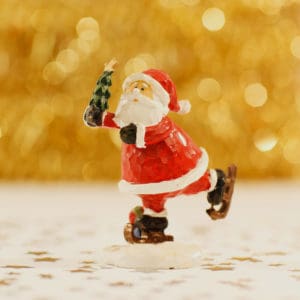
Controversy and criticism continues in the present-day, where some Christian and non-Christians have claimed that an affront to Christmas (dubbed a “war on Christmas” by some) is ongoing. Some of these critics claim that any specific mention of the term “Christmas” or its religious aspects was being increasingly censored, avoided, or discouraged by a number of advertisers, retailers, government (prominently schools), and other public and secular organizations into the 21st century.
การโต้เถียงและวิพากษ์วิจารณ์ยังคงดำเนินต่อมาเรื่อย ๆ จนถึงยุคปัจจุบันนี้ ซึ่งทั้งกลุ่มชาวคริสเตียนและกลุ่มที่ไม่ใช่ต่างก็สบประมาทกันและกันเกี่ยวกับเรื่องเทศกาลคริสต์มาสนี้เรื่อยมา (ซึ่งถูกตั้งชื่อเล่นให้ว่า “สงครามเทศกาลคริสต์มาส” โดยบางกลุ่มคน) ส่วนนักวิจารณ์บางคนก็แสดงทัศนะว่า ข้อมูลจำเพาะในการอ้างอิงถึงเทศกาลคริสต์มาส หรือเกี่ยวกับมุมมองทางด้านศาสนา มักจะถูกควบคุมเนื้อหามากกว่าปกติ หรือถูกทำให้ห่างจากความเป็นจริง หรือถูกกีดกันโดยกลุ่มคนที่ทำการโฆษณา ผู้ขายปลีก ส่วนราชการ (โรงเรียนที่มีชื่อเสียง) สื่อสาธารณะอื่น ๆ และองค์กรที่หวังประโยชน์จากงานเฉลิมฉลองในศตวรรษที่ 21 นี้

เศรษฐกิจช่วงคริสต์มาส
Christmas is typically the largest annual economic stimulus for many nations. Sales increase dramatically in almost all retail areas and shops introduce new products as people purchase gifts, decorations, and supplies.
In the U.S., the “Christmas shopping season” generally begins on Black Friday, the day after Thanksgiving, though many American stores begin selling Christmas items as early as October. In Canada, merchants begin advertising campaigns just before Halloween (October 31), and step up their marketing following Remembrance Day on November 11.
วันคริสต์มาสเป็นเทศกาลที่สำคัญมากในการเป็นตัวกระตุ้นเศรษฐกิจในทุก ๆ ปีของหลายประเทศ ยอดจำหน่ายสินค้าของร้านค้าปลีกจะเพิ่มขึ้นอย่างรวดเร็ว และร้านค้าเหล่านั้นก็จะออกสินค้าใหม่ ๆ มาในช่วงที่ผู้คนหาซื้อของขวัญ เครื่องประดับบ้านเรือนต่าง ๆ และอาหาร
ในอเมริกาจะจัด “เทศกาลซื้อของวันคริสต์มาส” ในวันแบล็คฟรายเดย์ (คือวันหลังจากวันขอบคุณพระเจ้า) อย่างไรก็ดี ร้านค้าส่วนใหญ่ในอเมริกาจะเริ่มขายของเกี่ยวกับวันคริสต์มาสตั้งแต่ต้นเดือนตุลาคม ในแคนาดา เหล่าพ่อค้าจะเริ่มโฆษณาสินค้าและกิจกรรมต่าง ๆ ตั้งแต่ก่อนวันฮอลโลวีน (31 ตุลาคม) แล้วก็เริ่มทำการขายหลังจากวัน Remembrance Day ในวันที่ 11 พฤศจิกายน
Figures from the U.S. Census Bureau reveal that expenditure in department stores nationwide rose from $20.8 billion in November 2004 to $31.9 billion in December 2004, an increase of 54 percent. In other sectors, the pre-Christmas increase in spending was even greater, there being a November – December buying surge of 100 percent in bookstores and 170 percent in jewelry stores. In the same year employment in American retail stores rose from 1.6 million to 1.8 million in the two months leading up to Christmas. Industries completely dependent on Christmas include Christmas cards, of which 1.9 billion are sent in the United States each year, and live Christmas Trees, of which 20.8 million were cut in the USA in 2002.[98]

กองการสำมะโนครัว ประเทศอเมริกา เปิดเผยตัวเลขการใช้จ่ายเงินในห้างสรรพสินค้าทั่วประเทศ มีอัตราเพิ่มขึ้นจาก 20.8 พันล้านเหรียญสหรัฐ ในเดือนพฤศจิกายน 2004 เป็น 31.9 พันล้านเหรียญสหรัฐ ในเดือนธันวาคม ปีเดียวกัน เพิ่มขึ้นถึง 54 เปอร์เซ็นต์
ส่วนร้านที่ขายสินค้าอื่น ๆ นั้น ก่อนถึงเทศกาลคริสต์มาส มีอัตราการซื้อสูงขึ้นมากกว่าปกติค่อนข้างมาก โดยเฉพาะในช่วงของเดือนพฤศจิกายน – เดือนธันวาคม ในร้านขายหนังสือ มีอัตราการซื้อเติบโตขึ้น 100 % ส่วนร้านเพชรพลอยนั้น มีอัตราการซื้อเติบโตขึ้น 170 % ในปีเดียวกันนี้ การจ้างงานของร้านขายปลีกได้เพิ่มขึ้นจาก 1.6 ล้าน เป็น 1.8 ล้าน ภายในระยะเวลา 2 เดือนก่อนถึงคริสต์มาส อุตสาหกรรมส่วนใหญ่ก็เน้นไปที่การผลิตสินค้าที่เกี่ยวกับเทศกาลนี้ ซึ่งรวมถึง การ์ดอวยพรวันคริสต์มาส ซึ่งจากตัวเลขประมาณการ การ์ดอวยพรวันคริสต์มาสถูกส่งให้กันในอเมริกาต่อปี มีจำนวนสูงถึง 1.9 พันล้านใบ และต้นสนที่นำมาใช้เป็นต้นคริสต์มาสถูกตัดในเทศกาลนี้สูงถึง 2.8 ล้านต้นในปี 2002
In most areas, Christmas Day is the least active day of the year for business and commerce; almost all retail, commercial and institutional businesses are closed, and almost all industries cease activity (more than any other day of the year). In England and Wales, the Christmas Day (Trading) Act 2004 prevents all large shops from trading on Christmas Day. Scotland is currently planning similar legislation. Film studios release many high-budget movies in the holiday season, including Christmas films, fantasy movies or high-tone dramas with high production values.
แต่ในหลายพื้นที่ วันคริสต์มาสก็เป็นช่วงที่เงียบเหงาที่สุดในรอบปีของธุรกิจการค้าประเภทอื่น ซึ่งส่วนใหญ่จะปิดให้บริการในช่วงนี้กัน ซึ่งรวมถึงธุรกิจทางด้านอุตสาหกรรมด้วย ในประเทศอังกฤษและเวลส์ มีกฎหมายการค้าปี 2004 ระบุไว้ว่า ห้ามห้างสรรพสินค้าขนาดใหญ่เปิดทำการในวันคริสต์มาส ซึ่งประเทศสก็อตแลนด์ก็กำลังวางแผนที่จะออกกฎเกณฑ์คล้าย ๆ กันนี้ ส่วนทางด้านภาพยนต์ ก็จะมีการฉายภาพยนตร์ที่ใช้ต้นทุนในการสร้างสูงในช่วงวันหยุดของเทศกาล รวมถึงภาพยนตร์เกี่ยวกับวันคริสต์มาส ภาพยนตร์แฟนตาซี หรือละครชีวิตที่ดีเยี่ยมโดยใช้ทีมงานคุณภาพในการผลิต

คำค้น ประวัติวันคริสต์มาส ประวัติคริสต์มาส ความเป็นมา เทศกาลคริสต์มาส Christmas History แปล
ขอบคุณข้อมูลจาก https://en.wikipedia.org

